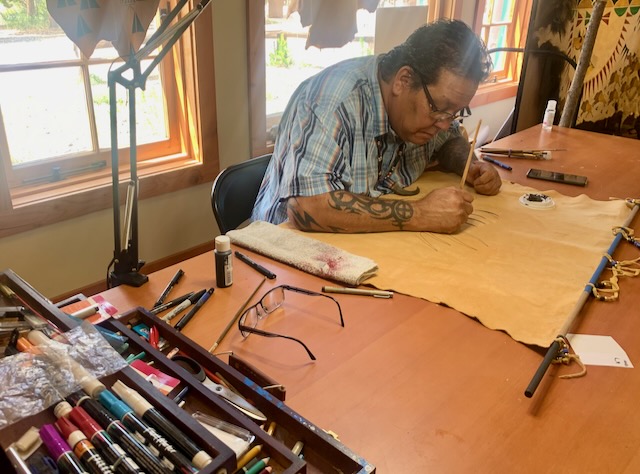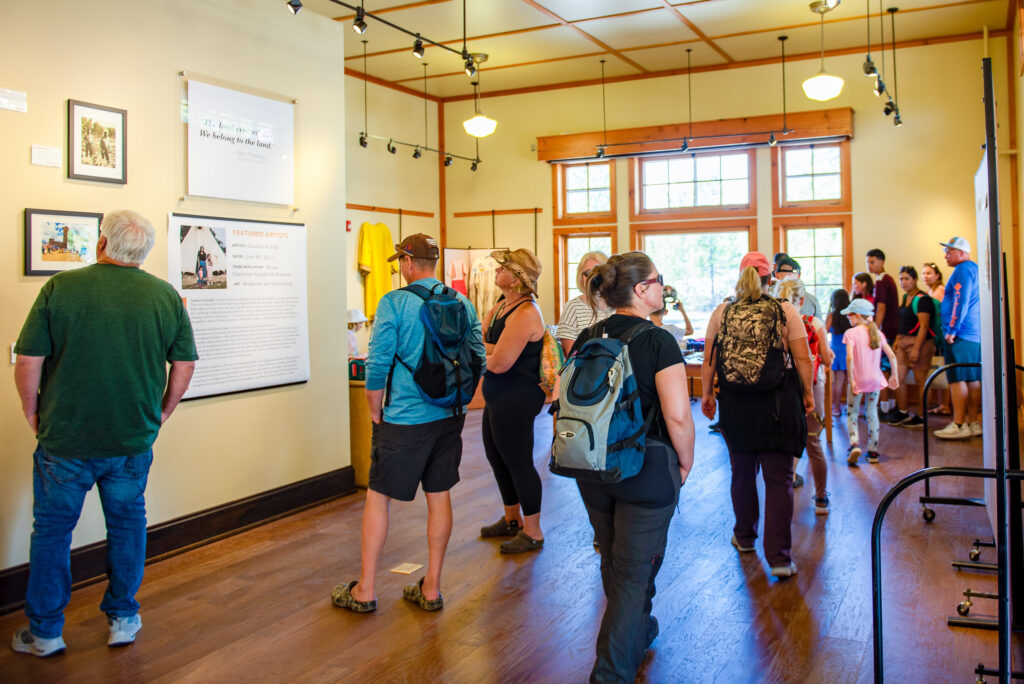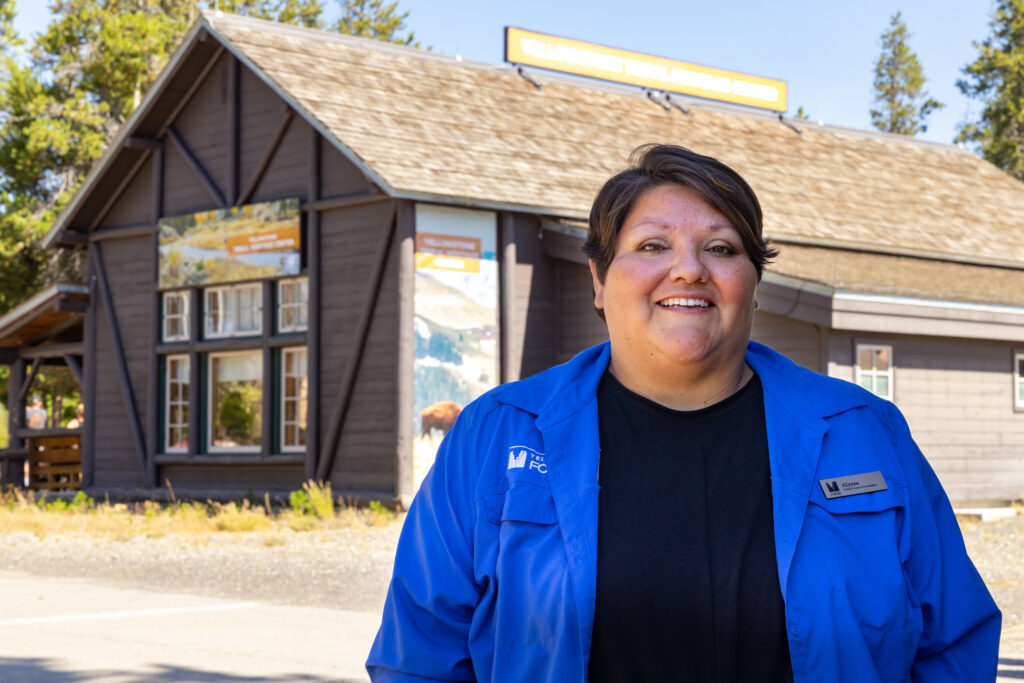
This story has been updated as of August 31, 2023 at 4:00 p.m. MT to correct the spelling of the Muscogee Nation.
OLD FAITHFUL, Wyo. — One of the earliest and most destructive foundational myths about Yellowstone National Park was that just a small number of Indigenous people had long ago made only a limited seasonal use of the area. Or that Natives avoided the park altogether out of a “fear of evil spirits” connected to geysers and other thermal features.

That myth has since been comprehensively disproven by nearly 2,000 archaeological sites identified within the park showing an Indigenous presence there dating back at least 11,000 years. But the convenient canard was often repeated by encroaching whites and early Yellowstone administrators as justification for excluding tribes from the park, while promoting it as a tourist wonderland for well-heeled Easterners.
But now, building on a pilot program that began last year, the Yellowstone Tribal Heritage Center is offering dozens of Native American artists, scholars, performers, craftspeople and other presenters (many of whom live in Wyoming and Montana) a place where they can interact directly with visitors and share their longstanding connections with the land.
“There is a lot of nice energy coming through this place,” said artist Evans Flammond Sr. on August 10 while painting a deer hide at the Center, located just steps away from Old Faithful Geyser. “It’s as comfortable as my studio at home.”
A Sicangu Lakota of the Rosebud Sioux Tribe, Flammond lives in Oglala, South Dakota and is one of 37 presenters featured at the Center this summer and through mid-October.

Flammond was making productive use of his nine-day residency at the Center earlier this month, working on a range of hide paintings, ledger art and other projects while visitors stopped to ask questions or “chew the fat about different art techniques,” as he put it.
Most people want to know how long he has been painting or where he’s headed next. But others sometimes make an emotional connection with his art, Flammond said, which is one of his favorite things about painting in public.
“I can also guarantee you that there’s some up-and-coming artist, whether he’s 10 years old or 50, that will see something I’m doing and pick up on a technique I show them, and they’ll remember that,” he said.
Learning a lot
Alyssa McGeeley, a member of the Muscogee Nation and coordinator for the Center, said she has learned a lot herself since the facility opened in May 2022.
One presenter captivated audiences with a discussion and display of edible and medicinal plants, McGeeley said. Several traditional woven bags that were part of the collection turned out to be not only functional and beautiful, she learned, but also used for food storage, because they were made from natural materials that deterred rodents.
McGeeley said she enjoys watching park visitors learn about the heritage and present-day cultures of the 27 tribes recognized by the National Park Service as having historical and current connections to Yellowstone.

Located in what was once the historic Haynes Photo Shop, the approximately 1,500-square-foot center includes a workspace for visiting artists and presenters and a book and gift shop area. Artists typically fare well in selling their wares alongside educational materials and other items, McGeeley said, particularly when a rush of people arrive immediately after Old Faithful erupts.
The Center is a cooperative effort between the National Park Service and Yellowstone Forever, the official nonprofit partner of Yellowstone National Park. It has also received financial support from the National Park Foundation.
It is one of several projects that grew out of discussions leading up to the park’s 150th anniversary last year seeking to invite and sustain active Native presences in Yellowstone.
Speaking in 2022 about those efforts, Superintendent Cam Sholly said the Park Service was looking at “engaging tribes at much, much higher levels and having them back in the park with us regularly and engaging visitors.”
Partnerships formed with tribes last year were “a launching point for the future, not just a one-time thing,” he said.
Fundraising underway
Fundraising is already underway to continue the Yellowstone Tribal Heritage Center in the same location next year, bringing together another roster of presenters.
For visitors like Hal Jones and Shari Burnum, who had traveled from Alabama and were spending time in the Center to watch Flammond paint, it was a welcome bonus attraction at Old Faithful.
“Seeing these people who were originally here again having a place like this at the table, that’s what it’s all about,” said Jones.
“You’ve got people coming in from all over the world, and to have people here who can speak to them about their heritage here is great,” Burnum said. “And what they create can become a lifelong memorial of your visit. It’s not just a typical gift shop.”
Flammond said he doesn’t mind when visitors ask questions about Native life.

“Sometimes they ask us if we still live in tepees,” he said. “In a way, it’s kind of a legitimate question if that’s all TV and movies show. It don’t offend me. But there are more and more Native American film directors out there, so one day the world will pretty much know not to ask that question.”
McGeeley said some visitors tell her she’s the only Native American they have ever met.
“I tell them that they probably have met Native people, they just don’t know it,” she said with a laugh. “It’s not like we all walk around in buckskins.”
Some visitors might be uncomfortable learning details about the many ugly truths surrounding how Indigenous people have been mistreated throughout American history.
But, McGeeley said, sharing and hearing those facts and stories are an important part of healing past wounds, and besides, “understanding the history doesn’t make you responsible for it.”
The Yellowstone Tribal Heritage Center is open through Oct. 14 with presenters on hand 10 a.m. to 4 p.m. Check out the schedule and other details here.
Republished with permission from Wyoming Truth.
